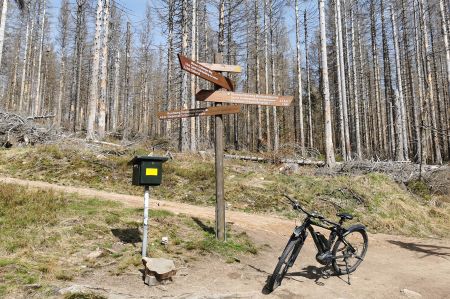Riding e-bike to the Dreibrodestein near St. Andreasberg
- Written by Portal Editor
Between Sankt Andreasberg and Sonneberg there are not only many hiking and cycling destinations, but also the so-called Dreibrodestein, three massive blocks of granite, which should be the destination of today's cycling tour.
So it goes first again in the direction of Ziegenbergerteich to the left in the direction of Brautbrunnen / Braunseck, where the Harzer stamp point 138 is located. Via Zimmermannsplatz we reach the village of Riefensbeek, where we follow the course of the Söse for a while on Landstrasse 498 to the Grosse Söse junction.
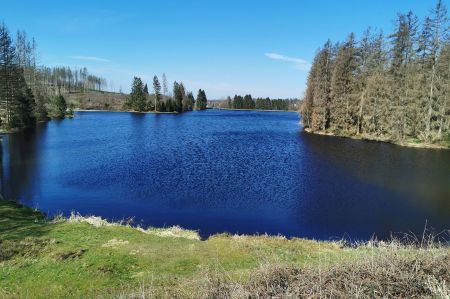 Now we follow the course of the Große Söse, turn right just before the large weir in the direction of Siebertalhütte and follow the GPS path. By the way: the Siebertalhütte is a special stamping point. We continue to follow the directions of our GPS and after about 26 kilometres we have reached our destination Dreibrodestein. The Dreibrodestein is also stamp number 154 of the Harzer hiking nobility. And to get straight to the point: That was not an easy route, constantly uphill and downhill, sometimes gravel, sometimes root track! So the decision is quickly made to take the way back after a stopover in St. Andreasberg via the L519 and then the federal road 242. But now, first of all, the attention belongs to the Dreibrodestein.
Now we follow the course of the Große Söse, turn right just before the large weir in the direction of Siebertalhütte and follow the GPS path. By the way: the Siebertalhütte is a special stamping point. We continue to follow the directions of our GPS and after about 26 kilometres we have reached our destination Dreibrodestein. The Dreibrodestein is also stamp number 154 of the Harzer hiking nobility. And to get straight to the point: That was not an easy route, constantly uphill and downhill, sometimes gravel, sometimes root track! So the decision is quickly made to take the way back after a stopover in St. Andreasberg via the L519 and then the federal road 242. But now, first of all, the attention belongs to the Dreibrodestein.
What is wool sack weathering and that in granite rocks?
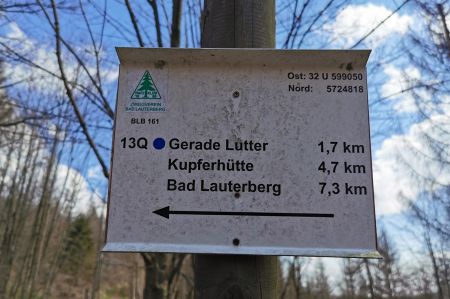 The Dreibrodestein imposingly and impressively illustrates the elemental forces of nature, here in particular the Ice Age, since these boulders were transported from Scandinavia and deposited here in the Harz Mountains. The blocks were probably no longer brought in Scandinavia (just kidding). The Dreibrodestein also impressively shows the chemical and physical violence of weathering, which is typically referred to as wool sack weathering for such granite formations.
The Dreibrodestein imposingly and impressively illustrates the elemental forces of nature, here in particular the Ice Age, since these boulders were transported from Scandinavia and deposited here in the Harz Mountains. The blocks were probably no longer brought in Scandinavia (just kidding). The Dreibrodestein also impressively shows the chemical and physical violence of weathering, which is typically referred to as wool sack weathering for such granite formations.
Wool sack weathering is a special form of rock weathering. Through the interaction of physical and chemical processes, rounded-edge blocks of rock are formed during wool sack weathering, which are stacked on top of each other like pillows, mattresses or wool sacks. The figurative term "wool sack" is derived from coarse sacks filled with wool, which historically in particular were used both as a sleeping pad and for transporting wool.
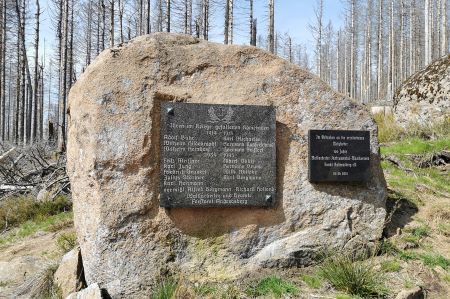 This weathering phenomenon can be observed mainly in coarse-crystalline, massive rocks such as granite, granodiorite, diorite and corresponding gneiss, sometimes also in sandstone. The "wool sacks" often form largely vegetation-free rock castles, such as on the Externsteine and in many places in the Harz Mountains, in the Black Forest on the Karlstein near Hornberg and on the Günterfelsen near Furtwangen, in the Teufelskueche in the Upper Palatinate Forest or extensively in the form of rock seas, in the Luisenburg rock labyrinth in the Fichtelgebirge, in the Blockheide (Waldviertel, Lower Austria) or in the Felsenmeer in the Odenwald. In the Saxon Ore Mountains, the "Hefekloßfelsen am Brandberg" near Breitenbrunn/Erzgebirge is also a popular destination due to its shape.
This weathering phenomenon can be observed mainly in coarse-crystalline, massive rocks such as granite, granodiorite, diorite and corresponding gneiss, sometimes also in sandstone. The "wool sacks" often form largely vegetation-free rock castles, such as on the Externsteine and in many places in the Harz Mountains, in the Black Forest on the Karlstein near Hornberg and on the Günterfelsen near Furtwangen, in the Teufelskueche in the Upper Palatinate Forest or extensively in the form of rock seas, in the Luisenburg rock labyrinth in the Fichtelgebirge, in the Blockheide (Waldviertel, Lower Austria) or in the Felsenmeer in the Odenwald. In the Saxon Ore Mountains, the "Hefekloßfelsen am Brandberg" near Breitenbrunn/Erzgebirge is also a popular destination due to its shape.
Legends and myths about the Dreibrodestein
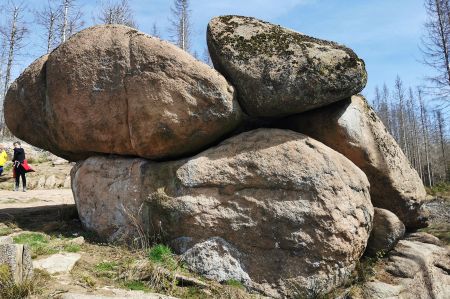 According to legend, the rocks were made from three loaves of bread from a heartless woman who didn't want to help a starving miner.
According to legend, the rocks were made from three loaves of bread from a heartless woman who didn't want to help a starving miner.
With the words "I'd rather have my three loaves of bread turned into stones", she ignored the miner and the loaves of bread then grew into huge stones and pushed the woman into the mossy underground.
The granite blocks should therefore be a warning against heartlessness.
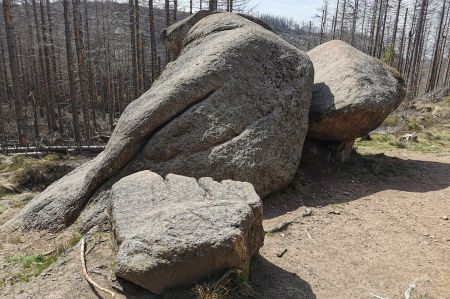 Another legend goes like this: Between eleven and twelve o'clock at night, the Haulemutter, who is also called Frau Holle, always finds herself at the three stones, which look like three huge loaves of bread stacked on top of one another.
Another legend goes like this: Between eleven and twelve o'clock at night, the Haulemutter, who is also called Frau Holle, always finds herself at the three stones, which look like three huge loaves of bread stacked on top of one another.
Then she sits on the rocks and weeps miserably - hence her nickname of Haulemutter.
The wretched mother is damned and the stones were once loaves of bread. Only if someone can turn the stones back into loaves of bread will she be redeemed.
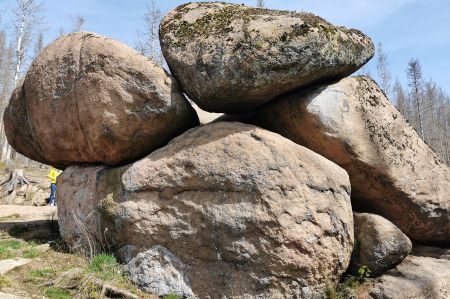 A mountain stream called “Dreibrodewasser” flows in the valley below the stones. In the summer, on certain days, it can happen that the aforementioned Frau Holle jumps on the backs of passers-by. She does this out of sheer rage because no one comes to redeem her. She then forces the unfortunate ones to carry her to the creek, a walk of about seven minutes.
A mountain stream called “Dreibrodewasser” flows in the valley below the stones. In the summer, on certain days, it can happen that the aforementioned Frau Holle jumps on the backs of passers-by. She does this out of sheer rage because no one comes to redeem her. She then forces the unfortunate ones to carry her to the creek, a walk of about seven minutes.
Wooden benches and tables on the Dreibrodestein also invite us to have a picnic. Here we met an older lady who told us about her hikes in the Harz Mountains, after all, for 60 years, so she knows every climb.
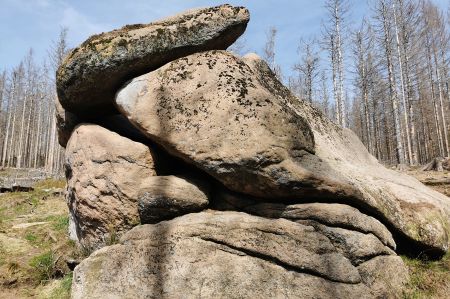 Immediately next to the small rest area there is a war memorial for the forest workers and officials of the St. Andreasberg Forestry Office who died in both world wars. Of course, there is also a more leisurely way: The "Dreibrodesteine" car park on the L519, from where you can reach the natural monument after just 1 km. From this car park it is also possible to hike the short, barrier-free path to the "Rehberger Grabenhaus" HWN 155.
Immediately next to the small rest area there is a war memorial for the forest workers and officials of the St. Andreasberg Forestry Office who died in both world wars. Of course, there is also a more leisurely way: The "Dreibrodesteine" car park on the L519, from where you can reach the natural monument after just 1 km. From this car park it is also possible to hike the short, barrier-free path to the "Rehberger Grabenhaus" HWN 155.
We save the Rehberger Grabenhaus for another tour.
Please read as well:
